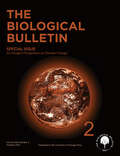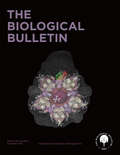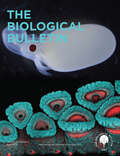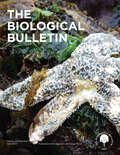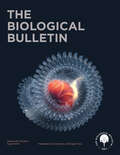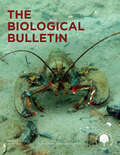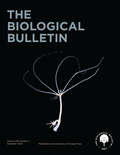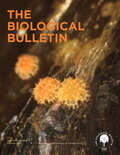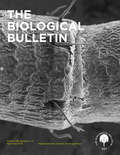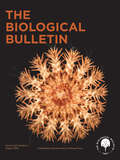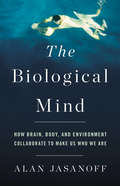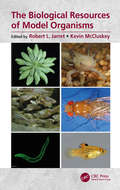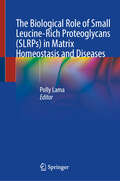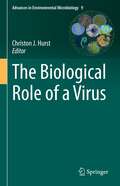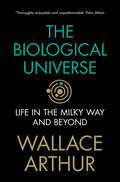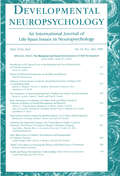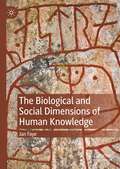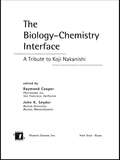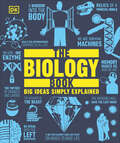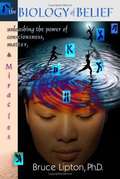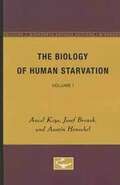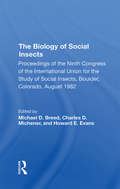- Table View
- List View
The Biological Bulletin, volume 243 number 2 (October 2022)
by The Biological BulletinThis is volume 243 issue 2 of The Biological Bulletin. The Biological Bulletin disseminates novel scientific results in broadly related fields of biology in keeping with more than 100 years of a tradition of excellence. The Bulletin publishes outstanding original research with an overarching goal of explaining how organisms develop, function, and evolve in their natural environments. To that end, the journal publishes papers in the fields of Neurobiology and Behavior, Physiology and Biomechanics, Ecology and Evolution, Development and Reproduction, Cell Biology, Symbiosis and Systematics. The Bulletin emphasizes basic research, including articles on marine model systems and those of an interdisciplinary nature.
The Biological Bulletin, volume 243 number 3 (December 2022)
by The Biological BulletinThis is volume 243 issue 3 of The Biological Bulletin. The Biological Bulletin disseminates novel scientific results in broadly related fields of biology in keeping with more than 100 years of a tradition of excellence. The Bulletin publishes outstanding original research with an overarching goal of explaining how organisms develop, function, and evolve in their natural environments. To that end, the journal publishes papers in the fields of Neurobiology and Behavior, Physiology and Biomechanics, Ecology and Evolution, Development and Reproduction, Cell Biology, Symbiosis and Systematics. The Bulletin emphasizes basic research, including articles on marine model systems and those of an interdisciplinary nature.
The Biological Bulletin, volume 244 number 1 (February 2023)
by The Biological BulletinThis is volume 244 issue 1 of The Biological Bulletin. The Biological Bulletin disseminates novel scientific results in broadly related fields of biology in keeping with more than 100 years of a tradition of excellence. The Bulletin publishes outstanding original research with an overarching goal of explaining how organisms develop, function, and evolve in their natural environments. To that end, the journal publishes papers in the fields of Neurobiology and Behavior, Physiology and Biomechanics, Ecology and Evolution, Development and Reproduction, Cell Biology, Symbiosis and Systematics. The Bulletin emphasizes basic research, including articles on marine model systems and those of an interdisciplinary nature.
The Biological Bulletin, volume 244 number 2 (April 2023)
by The Biological BulletinThis is volume 244 issue 2 of The Biological Bulletin. The Biological Bulletin disseminates novel scientific results in broadly related fields of biology in keeping with more than 100 years of a tradition of excellence. The Bulletin publishes outstanding original research with an overarching goal of explaining how organisms develop, function, and evolve in their natural environments. To that end, the journal publishes papers in the fields of Neurobiology and Behavior, Physiology and Biomechanics, Ecology and Evolution, Development and Reproduction, Cell Biology, Symbiosis and Systematics. The Bulletin emphasizes basic research, including articles on marine model systems and those of an interdisciplinary nature.
The Biological Bulletin, volume 244 number 3 (June 2023)
by The Biological BulletinThis is volume 244 issue 3 of The Biological Bulletin. The Biological Bulletin disseminates novel scientific results in broadly related fields of biology in keeping with more than 100 years of a tradition of excellence. The Bulletin publishes outstanding original research with an overarching goal of explaining how organisms develop, function, and evolve in their natural environments. To that end, the journal publishes papers in the fields of Neurobiology and Behavior, Physiology and Biomechanics, Ecology and Evolution, Development and Reproduction, Cell Biology, Symbiosis and Systematics. The Bulletin emphasizes basic research, including articles on marine model systems and those of an interdisciplinary nature.
The Biological Bulletin, volume 245 number 1 (August 2023)
by The Biological BulletinThis is volume 245 issue 1 of The Biological Bulletin. The Biological Bulletin disseminates novel scientific results in broadly related fields of biology in keeping with more than 100 years of a tradition of excellence. The Bulletin publishes outstanding original research with an overarching goal of explaining how organisms develop, function, and evolve in their natural environments. To that end, the journal publishes papers in the fields of Neurobiology and Behavior, Physiology and Biomechanics, Ecology and Evolution, Development and Reproduction, Cell Biology, Symbiosis and Systematics. The Bulletin emphasizes basic research, including articles on marine model systems and those of an interdisciplinary nature.
The Biological Bulletin, volume 245 number 2 (October 2023)
by The Biological BulletinThis is volume 245 issue 2 of The Biological Bulletin. The Biological Bulletin disseminates novel scientific results in broadly related fields of biology in keeping with more than 100 years of a tradition of excellence. The Bulletin publishes outstanding original research with an overarching goal of explaining how organisms develop, function, and evolve in their natural environments. To that end, the journal publishes papers in the fields of Neurobiology and Behavior, Physiology and Biomechanics, Ecology and Evolution, Development and Reproduction, Cell Biology, Symbiosis and Systematics. The Bulletin emphasizes basic research, including articles on marine model systems and those of an interdisciplinary nature.
The Biological Bulletin, volume 245 number 3 (December 2023)
by The Biological BulletinThis is volume 245 issue 3 of The Biological Bulletin. The Biological Bulletin disseminates novel scientific results in broadly related fields of biology in keeping with more than 100 years of a tradition of excellence. The Bulletin publishes outstanding original research with an overarching goal of explaining how organisms develop, function, and evolve in their natural environments. To that end, the journal publishes papers in the fields of Neurobiology and Behavior, Physiology and Biomechanics, Ecology and Evolution, Development and Reproduction, Cell Biology, Symbiosis and Systematics. The Bulletin emphasizes basic research, including articles on marine model systems and those of an interdisciplinary nature.
The Biological Bulletin, volume 246 number 1 (February 2024)
by The Biological BulletinThis is volume 246 issue 1 of The Biological Bulletin. The Biological Bulletin disseminates novel scientific results in broadly related fields of biology in keeping with more than 100 years of a tradition of excellence. The Bulletin publishes outstanding original research with an overarching goal of explaining how organisms develop, function, and evolve in their natural environments. To that end, the journal publishes papers in the fields of Neurobiology and Behavior, Physiology and Biomechanics, Ecology and Evolution, Development and Reproduction, Cell Biology, Symbiosis and Systematics. The Bulletin emphasizes basic research, including articles on marine model systems and those of an interdisciplinary nature.
The Biological Bulletin, volume 246 number 2-3 (April 2024)
by The Biological BulletinThis is volume 246 issue 2-3 of The Biological Bulletin. The Biological Bulletin disseminates novel scientific results in broadly related fields of biology in keeping with more than 100 years of a tradition of excellence. The Bulletin publishes outstanding original research with an overarching goal of explaining how organisms develop, function, and evolve in their natural environments. To that end, the journal publishes papers in the fields of Neurobiology and Behavior, Physiology and Biomechanics, Ecology and Evolution, Development and Reproduction, Cell Biology, Symbiosis and Systematics. The Bulletin emphasizes basic research, including articles on marine model systems and those of an interdisciplinary nature.
The Biological Bulletin, volume 247 number 1 (August 2024)
by The Biological BulletinThis is volume 247 issue 1 of The Biological Bulletin. The Biological Bulletin disseminates novel scientific results in broadly related fields of biology in keeping with more than 100 years of a tradition of excellence. The Bulletin publishes outstanding original research with an overarching goal of explaining how organisms develop, function, and evolve in their natural environments. To that end, the journal publishes papers in the fields of Neurobiology and Behavior, Physiology and Biomechanics, Ecology and Evolution, Development and Reproduction, Cell Biology, Symbiosis and Systematics. The Bulletin emphasizes basic research, including articles on marine model systems and those of an interdisciplinary nature.
The Biological Evolution of Religious Mind and Behavior
by Eckart Voland Wulf SchiefenhövelIn a Darwinian world, religious behavior - just like other behaviors - is likely to have undergone a process of natural selection in which it was rewarded in the evolutionary currency of reproductive success. This book aims to provide a better understanding of the social scenarios in which selection pressure led to religious practices becoming an evolved human trait, i.e. an adaptive answer to the conditions of living and surviving that prevailed among our prehistoric ancestors. This aim is pursued by a team of expert authors from a range of disciplines. Their contributions examine the relevant physiological, emotional, cognitive and social processes. The resulting understanding of the functional interplay of these processes gives valuable insights into the biological roots and benefits of religion.
The Biological Mind: How Brain, Body, and Environment Collaborate to Make Us Who We Are
by Alan JasanoffA pioneering neuroscientist argues that we are more than our brainsTo many, the brain is the seat of personal identity and autonomy. But the way we talk about the brain is often rooted more in mystical conceptions of the soul than in scientific fact. This blinds us to the physical realities of mental function. We ignore bodily influences on our psychology, from chemicals in the blood to bacteria in the gut, and overlook the ways that the environment affects our behavior, via factors varying from subconscious sights and sounds to the weather. As a result, we alternately overestimate our capacity for free will or equate brains to inorganic machines like computers. But a brain is neither a soul nor an electrical network: it is a bodily organ, and it cannot be separated from its surroundings. Our selves aren't just inside our heads--they're spread throughout our bodies and beyond. Only once we come to terms with this can we grasp the true nature of our humanity.
The Biological Resources of Model Organisms: Collection, Characterization and Applications
by Robert L. Jarret and Kevin McCluskeyThis book discusses 14 model organisms and are used by thousands of researchers, teachers, and students each year in laboratories and classrooms, around the globe. Though acknowledged in innumerable scientific journal articles, little is generally known about the origin of these collections, how the organisms contained within them have been acquired, and how they are maintained and distributed. While some collections such as Drosophila have long histories others, such as the collection of Brachionus, are relatively new. They vary greatly in size. Yet, all have contributed and are continuing to contribute to global research efforts in many areas of scientific research as diverse as tissue regeneration, skin cancer, evolution, water purity, gene function, and hundreds of others. In addition to providing the raw materials for national and international research programs, these collections also provide educational tools used by colleges and high schools. The chapters in this book attempt to provide a brief look at the individual organisms, how they came to be accepted as model organisms, the history of the individual collections, examples of how the organisms have been and are being used in scientific research, and a description of the facilities and procedures used to maintain them. Features: • Provides an in-depth look at the collections of 14 model organisms that have enabled innumerable scientific breakthroughs over decades, and that continue to do so. • Includes detailed descriptions of the operating procedures used for the maintenance of each model organism collection. • Discusses the holdings of the collections of model organisms and its relevance to past, current and future scientific research. • Written by the leaders in the field of the management of model organisms.
The Biological Role of Small Leucine-Rich Proteoglycans (SLRPs) in Matrix Homeostasis and Diseases
by Polly LamaThis book covers advanced and up-to-date analyses of the synthesis, fragmentation, and dysregulation of Small Leucine-Rich Proteoglycans (SLRPs) in some common matrix-related diseases. These SLRPs act as autonomous triggers of inflammation in conditions such as cancer, cartilage tissue degeneration, renal (kidney) diseases, as well as skin, tendon, musculoskeletal, and craniofacial tissues, responding to stress, injury, and impairment of normal function. Chapters describe the significance behind the formation of proteolytic molecular fragments of SLRPs and why they alter inflammatory cell-signaling pathways, acting as Damage-Associated Molecular Patterns (DAMPs), that can function as Pathogen-Associated Molecular Patterns (PAMPs) in the early, intermediate, and advanced stages of matrix dysregulation and diseases. It also discusses evidence-based therapeutic approaches useful for identifying molecular fragments as potential biomarkers of matrix degeneration, providing a thorough understanding on the regulatory role of SLRPs in matrix homeostasis and diseases. The book is supplemented with well-illustrated figures, tabulated analysis, and critical review questions for further investigations that identifies gap in current understanding. The book is relevant for experts in medical sciences specializing in cell, extracellular matrix-based tissue analysis, researchers, as well as students interested in investigating matrix-related changes during the pathological progression of diseases.
The Biological Role of a Virus (Advances in Environmental Microbiology #9)
by Christon J. HurstThis book answers the question “What is it that viruses do?” by presenting three aspects of viral ecology. The first aspect explains how viruses affect the population diversity and energetics of their host communities. Perhaps the most notable example of this concept is our understanding that primary production within ecosystems often depends upon those viruses which serve as controllers of nutrient recycling, connecting the aquatic and terrestrial realms in ways that can be assessed locally and globally. The second aspect describes genetic partnerships which exist between hosts and their viruses. These include processes termed endogeny and lysogeny by which the host carries at least a partial genomic copy of the virus. Fluidity of these collective genomes is expressed on an evolutionary time scale and the mutual life cycles which they produce represent a forging of shared genomic fate that obligates partnership of the virus and its host. The viral sequences represent a source of potential benefit as well as potential peril for the host and can implement phenotypic changes in the host. Hosts often use those changes as tools. As humans, the most notable example would be that mammals rely upon temporary activation of their endogenous viral genes in order to successfully develop a placenta. The third aspect is defending the health of a host, which relies upon activity in two directions. Hosts often use their captured viral genes to identify and subsequently direct battle against invading viruses. This natural concept has been engineered for combating cancer, is useful for suppressing the detrimental consequences of genetic diseases, and has been developed to create targeted antiviral vaccines. But, the defense has to work in two directions and the host can use other symbiotic microorganisms as protection against its viruses. This book will appeal to a wide readership by providing a broad perspective of viral ecology, and all scientists will find it helpful for gaining a view of fields beyond their specialization.
The Biological Universe: Life in the Milky Way and Beyond
by Wallace ArthurAre we alone in the universe, or are there other life forms 'out there'? This is one of the most scientifically and philosophically important questions that humanity can ask. Now, in the early 2020s, we are tantalizingly close to an answer. As this book shows, the answer will almost certainly be that life forms are to be found across the Milky Way and beyond. They will be thinly spread, to be sure. Yet the number of inhabited planets probably runs into the trillions. Some are close enough for us to detect evidence of life by analysing their atmospheres. This evidence may be found within a couple of decades. Its arrival will be momentous. But even before it arrives we can anticipate what life elsewhere will be like by examining the ecology and evolution of life on Earth. This book considers the current state of play in relation to these titanic issues.
The Biological and Social Determinants of Child Development: A Special Double Issue of developmental Neuropsychology
by Steven M. LeharThe Biological and Social Determinants of Child Development stimulates cross-disciplinary communication and research collaboration in the field of child development. While the papers in this issue seem diverse in terms of topic and discipline, there are a number of common themes: *critical period for brain development and the importance of specific environmental input during this period; *importance of early brain development and enriched environments is supported in articles describing findings from human studies; *potential for brain plasticity following specialized retraining is found in a compelling paper demonstrating different profiles of brain activation for normal readers vs. those who have dyslexia and younger children at high risk for development of reading disabilities; and *critical period, brain plasticity, and parallel changes in developing behavior and brain structure and functioning. As a number of papers in this issue describe potential interventions, one is relevant because it describes the numerous factors that make results of such studies have the potential to generalize to larger populations. Putting the described papers in a broad perspective, the last article argues that we cannot understand the health status of a society without understanding the health-determining influences across the life course.
The Biological and Social Dimensions of Human Knowledge
by Jan FayeTraditionally, philosophers have argued that epistemology is a normative discipline and therefore occupied with an a priori analysis of the necessary and sufficient conditions that a belief must fulfill to be acceptable as knowledge. But such an approach makes sense only if human knowledge has some normative features, which conceptual analysis is able to disclose. As it turns out, philosophers have not been able to find such features unless they are very selective in their choice of examples of knowledge. Much of what we intuitively think functions as knowledge, both in human and non-human animals, does not share these normative features.The purpose of this book is to demonstrate that natural selection has adapted human sense impressions to deliver reliable information without meeting the traditional commitments for having knowledge. In connection with memory, sensory and bodily information provides an animal with experiential knowledge. Experiential knowledge helps an animal to navigate its environment. Moreover, experiential knowledge has different functions depending on whether the deliverance of information stems from the organism’s external or internal senses.
The Biology - Chemistry Interface: A Tribute To Koji Nakanishi
by Raymond CooperA tribute to the pioneering scientific work of Professor Koji Nakanishi, whose studies of natural products have effaced some of the conventional boundaries between biology and chemistry. It discusses an array of chromatographic separation methods and determination of structures on a microscale, analyzes bioassay-directed fractionation and other means of isolating biologically active compounds from plants and other sources, covers vital enzymes isolated from marine organisms such as algae, and more.
The Biology Book: Big Ideas Simply Explained (DK Big Ideas)
by DKLearn about the most important discoveries and theories of this science in The Biology Book.Part of the fascinating Big Ideas series, this book tackles tricky topics and themes in a simple and easy to follow format. Learn about Biology in this overview guide to the subject, great for novices looking to find out more and experts wishing to refresh their knowledge alike! The Biology Book brings a fresh and vibrant take on the topic through eye-catching graphics and diagrams to immerse yourself in. This captivating book will broaden your understanding of Biology, with:- More than 95 ideas and events key to the development of biology and the life sciences- Packed with facts, charts, timelines and graphs to help explain core concepts- A visual approach to big subjects with striking illustrations and graphics throughout- Easy to follow text makes topics accessible for people at any level of understandingThe Biology Book is a captivating introduction to understanding the living world and explaining how its organisms work and interact – whether microbes, mushrooms, or mammals. Here you&’ll discover key areas of the life sciences, including ecology, zoology, and biotechnology, through exciting text and bold graphics.Your Biology Questions, Simply ExplainedThis book will outline big biological ideas, like the mysteries of DNA and genetic inheritance; and how we learned to develop vaccines that control diseases. If you thought it was difficult to learn about the living world, The Biology Book presents key information in an easy to follow layout. Here you&’ll learn about cloning, neuroscience, human evolution, and gene editing, and be introduced to the scientists who shaped these subjects, such as Carl Linnaeus, Jean-Baptiste Lamarck, Charles Darwin, and Gregor Mendel.The Big Ideas SeriesWith millions of copies sold worldwide, The Biology Book is part of the award-winning Big Ideas series from DK. The series uses striking graphics along with engaging writing, making big topics easy to understand.
The Biology Book: From the Origin of Life to Epigenetics, 250 Milestones in the History of Biology (Union Square & Co. Milestones)
by Michael C. Gerald Gloria E. GeraldFrom the emergence of life, to Leewenhoeks microscopic world, to GMO crops, The Biology Book presents 250 landmarks in the most widely studied scientific field. Brief, engaging, and colorfully illustrated synopses introduce readers to every major subdiscipline, including cell theory, genetics, evolution, physiology, thermodynamics, molecular biology, and ecology. With information on such varied topics as paleontology, pheromones, nature vs. nurture, DNA fingerprinting, bioenergetics, and so much more, this lively collection will engage everyone who studies and appreciates the life sciences.
The Biology Of Belief: Unleashing The Power Of Consciousness, Matter And Miracles
by Bruce LiptonIn The Biology Of Believe Bruce Lipton explores celular development and how the environment plays a much more important roll in how life develops than conventional science ever thought. He challenges the belief that genetics control how we and all life develop and thrive ground breaking research. We once believed that the world was round but now marvel that anyone would have thought this. Bruce Lipton along with many micro biologist genetics are the blue print and plans but our environment and beliefs are the catolist that determine the quality of life.
The Biology Of Human Starvation: Volume I
by Josef Brozek Ancel Keys Austin HenschelThe Biology of Human Starvation was first published in 1950. Minnesota Archive Editions uses digital technology to make long-unavailable books once again accessible, and are published unaltered from the original University of Minnesota Press editions.With great areas of the world battling the persistent and basic problem of hunger, this work constitutes a major contribution to needed scientific knowledge. The publication is a definitive treatise on the morphology, biochemistry, physcology, psychology, and medical aspects of calorie undernutrition, cachexia, starvation, and rehabilitation in man. Presented critically and systematically are the fact and theory from the world literature, including the evidence from World War II and the finding of the Minnesota Starvation Experiment (1944*1946). Pertinent experiments and field and clinical observations to 1949 are covered. The extensive original research involved was conducted at the University of Minnesota Laboratory of Physiological Hygiene, which Dr. Keys heads. The authors, all of the laboratory staff, were assisted in preparation of the work by Ernst Simonson, Samuel Wells and Angie Sturgeon Skinner.
The Biology Of Social Insects: Proceedings Of The Ninth Congress Of The International Union For The Study Of Social Insects
by Howard E. Evans Charles D. Michener Michael D. BreedIn this book internationally known experts provide a comprehensive view of current knowledge of social insect biology including much previously unpublished information. Particular emphasis is given to the relationships between social insects and humans; sections are devoted to economically important social insects, pollination, foraging, and the role of insects in ecosystems and agroecosystems. The authors also discuss communication, behavior and caste within insect colonies. A special section focuses on the neurobiology of social insects. A series of papers considers the presocial insects, which live in family groups but without caste differences. Also well represented are the fields of sociobiology and the origins and evolution of social behavior. The book will be valuable to agricultural scientists as well as to entomologists, sociobiologists, ecologists, ethologists, and natural historians. Endocrinologists and neurobiologists will also find important new material.
